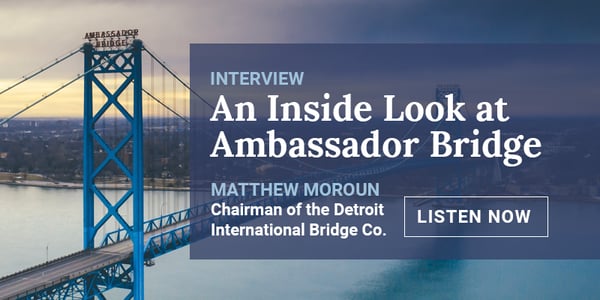An Inside Look at Ambassador Bridge - What the Closure and Reopening Means for Shippers
Feb 16, 2022
For the past few weeks the Ambassador Bridge that connects Windsor, Canada to Detroit, Michigan has made headlines since it became one of the main stages in the Canadian based trucker protest.
We reached into our outstanding network and asked our good friend, Matthew Moroun, to share his understanding of what took place there and the role this structure plays in the supply chain. Matthew is the Chairman of the Detroit International Bridge Co. that owns Ambassador Bridge. He is also the Chairman of Universal Logistics holding company.
Matthew provided some interesting facts. For example, the bridge accounts for 25% of the trade between the United States and Canada and first opened in 1929. As Matthew pointed out, until this event (a.k.a. the Convoy), it had never closed. The bridge survived the Great Depression, World War II, and September 11th, but somehow, the truckers figured out how to shut it down - something that has never been done in its 93 year history.
And that is why we’d strongly recommend that you listen to this interview as Matthew shares other great insights about what this event means for shippers. The closure demonstrated that truckers “know how the supply chain works better than most other people, even those in 'suits' that work in the supply chain," as well as the leaders from political and law enforcement areas. Since the number of drivers is finite and there is no elasticity in finding more drivers that have been vetted by the Canadian and U.S. governments, shippers are likely to see cross-border shipments delayed for the next couple of weeks.
Given the lack of elasticity of the driver supply as well as the closure of the bridge for the first time ever, Matthew emphasized that shippers need to ask: What’s our Plan B? This is consistent with a message we sent out in a Two Minute Warning a few weeks ago.
With the possibility of a “People’s Convoy” here in the United States looming on the horizon, we should all heed Matthew's concerns and ask: Does our company have a written supply chain plan that addresses Black Swan events or events which could disrupt our supply chain?
If your company doesn't have a written plan and you're wondering, “Where do we begin in creating this plan?” help is on the way. Our Supply Chain Edge team has successfully helped companies get their arms around their supply chain issues and create contingency plans which can help avoid supply chain disruptions.
So if you’re interested in information about how your company can create a supply chain plan that identifies the threats and risks to your supply chain and gives you options and alternatives, get in touch.
One final thing - we encourage you to take a look at our latest Freight Market Update if you haven't already.
BY MIKE REGAN, CO-FOUNDER OF TRANZACT
CONNECT ON LINKEDIN

